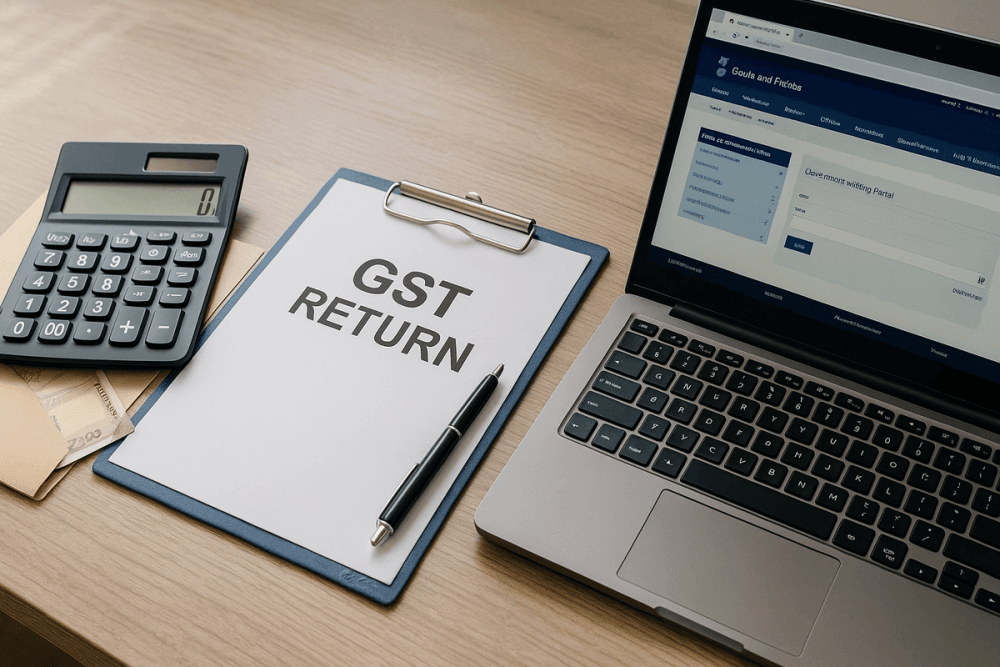GST Made Simple – a Practical FAQ
GST
for Small Businesses

GST Made Simple – a Practical FAQ
We’ve noticed several clients have recently registered under GST and are seeking a simplified understanding of how it affects them and their businesses. To address this, we’ve created a concise FAQ tailored for laymen, minimizing the need for technical knowledge while explaining the basics and logic of GST.
We encourage you to read through it to stay informed and up to date on the impact of GST on your business operations. This guide will help you navigate GST with clarity and confidence.
Think of GST as a pass-through, it’s not your money but a tax you collect and pass on to the government. It may feel complicated at first, but with some time spent understanding, it becomes a smooth part of your business.
What are direct and indirect taxes? How are they different?
Taxes come in two main types:
-
Direct Taxes, like income tax are paid directly to the government
-
Indirect Taxes, like GST, are collected by businesses on behalf of the government. As a business owner, you charge GST to customers and pass it to the government, making you a “collector” of tax rather than a payer
How does GST work? Who’s cost is it, and how does the flow of money work?
GST aims to charge the end user of a product. Each entity of the transaction flow deposits the GST applicable on their profit margin to the government. In this way, only the last link of a transaction pays the cost of GST. To simplify it – let’s try going through an example below.
Example (Assuming an 18% Tax Rate):
-
Raw Material Purchase by Mr. A:
-
Mr. A buys raw materials worth ₹1,00,000 and pays ₹1,18,000 (including ₹18,000 as GST)
-
The raw material sellers file GST returns and deposit ₹18,000 with the government
-
-
Product Sale by Mr. A to Mr. B:
-
Mr. A develops the raw materials into a product and sells it to Mr. B for ₹1,50,000 (profit = ₹50,000). He charges ₹27,000 GST (18% of ₹1,50,000), receiving ₹1,77,000 in total
-
Mr. A claims ITC of the ₹18,000 (GST paid on raw materials) and deposits only ₹9,000 (₹27,000 - ₹18,000) to the government
-
Net Cash Flow for Mr. B = ₹1,77,000 (sale + GST) – ₹1,18,000 (purchase + GST) – ₹9,000 (GST outflow) = ₹50,000, i.e. same as profit without considering GST
-
-
Final Cost for Mr. B:
-
If Mr. B is the end consumer, he cannot claim ITC, so the total cost to him is ₹1,77,000 (₹1,50,000 + ₹27,000 GST)
-
If Mr. B uses the product for further development and resale, he can claim ₹27,000 as ITC, effectively reducing his cost to ₹1,50,000
-
GST is ultimately a cost for the end consumer, as they cannot claim any Input Tax Credit (ITC). For GST-registered businesses, it’s usually not a cost since they can offset the GST paid on purchases (input GST) against the GST collected on sales (output GST). However, if a business deals with unregistered suppliers or sells exempt goods, GST might become a cost in those cases.
What is Input Tax Credit? For what, and how can I claim it?
As a GST-registered business, you can reduce the GST you pay on sales by claiming the GST you’ve already paid on business purchases. This is called Input Tax Credit (ITC).
How to Claim ITC?
-
Ensure you have a proper GST invoice
-
Confirm that the purchase is for business use. ITC is not available on personal expenses, and certain blocked items by the government, e.g., cars
-
Confirm that your supplier has filed their GST return and paid the tax
-
Ensure the details of the purchase are included in your GST filings
How does GST impact my cash flow?
GST payments are based on invoices raised, not on actual cash received. This can strain cash flow if customers delay payments. If invoices are raised within the same period as the receipt of money, there is no negative impact of GST on cash flow.
Example: You sell goods worth ₹1,00,000, at 18% GST. Even if the customer delays payment, you must pay ₹18,000 in GST to the government by the due date.
What is the impact of submitting incorrect data?
Filing incorrect data, such as claiming ineligible Input Tax Credit (ITC), can result in penalties and interest under the GST law:
-
Penalty for Wrong ITC Claim: 100% of the tax amount or ₹10,000 (whichever is higher)
-
Interest on Wrong ITC Claim: Interest at 18% per annum from date of claim to date of repayment
-
Other Penalties for Errors: Failing to rectify mismatches between your and your supplier’s returns can lead to denial of ITC
Double-check all invoices, reconcile data regularly, and ensure suppliers file their returns to avoid issues.
How does being registered affect my sales with unregistered entities?
When selling to unregistered customers, you must still charge GST on taxable goods or services. However, since unregistered entities cannot claim Input Tax Credit (ITC), the GST becomes a cost for them. Always include GST in your pricing discussions upfront to avoid confusion or resistance from unregistered customers.
What are the deadlines for filing of the GSTR returns? How often do I need to file them?
GST returns are to be filed monthly, however if your turnover does not exceed ₹5 crore per annum, you are eligible for relaxation, to file on a quarterly basis instead.
| Particulars | Monthly Filers | Quarterly Filers |
|---|---|---|
| GSTR-1 | 11th of next month | 13th of the month after the quarter ends |
| GSTR-3B | 20th of next month | 22nd of the month after the quarter ends* |
* while returns are filed quarterly, an approximate GST must be paid monthly by the 25th of next month for the first two months of the quarter.
What are the different GST rates? How do I know what to charge?
Different goods and services attract different GST rates:
-
0%: Basic food items like grains
-
5%: Essential goods like packaged food
-
12-18%: Standard rates for most goods and services
-
28%: Luxury items like high-end cars
Coordinate with us to identify the applicable GST rate for your supply.
When do you need to register for GST?
You need to register for GST if your business meets the following key conditions:
-
If your total sales exceed the turnover threshold for any year (₹20 lakh for service providers, ₹40 lakh for goods)
-
If you make sales across state boundaries, GST registration is mandatory even for a small sale
-
If you export and want to claim benefit of no GST, you must register to claim a Letter of Undertaking (LUT) and file regular returns
-
When dealing with MNCs and corporates, they often prefer / require their suppliers to be GST-registered for seamless transactions and to avail Input Tax Credit (ITC)
Note: if your business is not required to stay registered in future years, you can apply for cancellation at any time.
Registering for GST ensures compliance, allows you to claim Input Tax Credit (ITC), and facilitates smoother business operations, especially for exporters.
Conclusion: Managing GST smartly
GST can feel complex at first, but understanding how it affects your cash flow, pricing, and ITC can simplify things. Stay compliant, track your invoices, and work with GST-registered suppliers to minimize headaches.
GST isn’t just a tax—it’s part of your business operations. Mastering it means more control over your finances.
